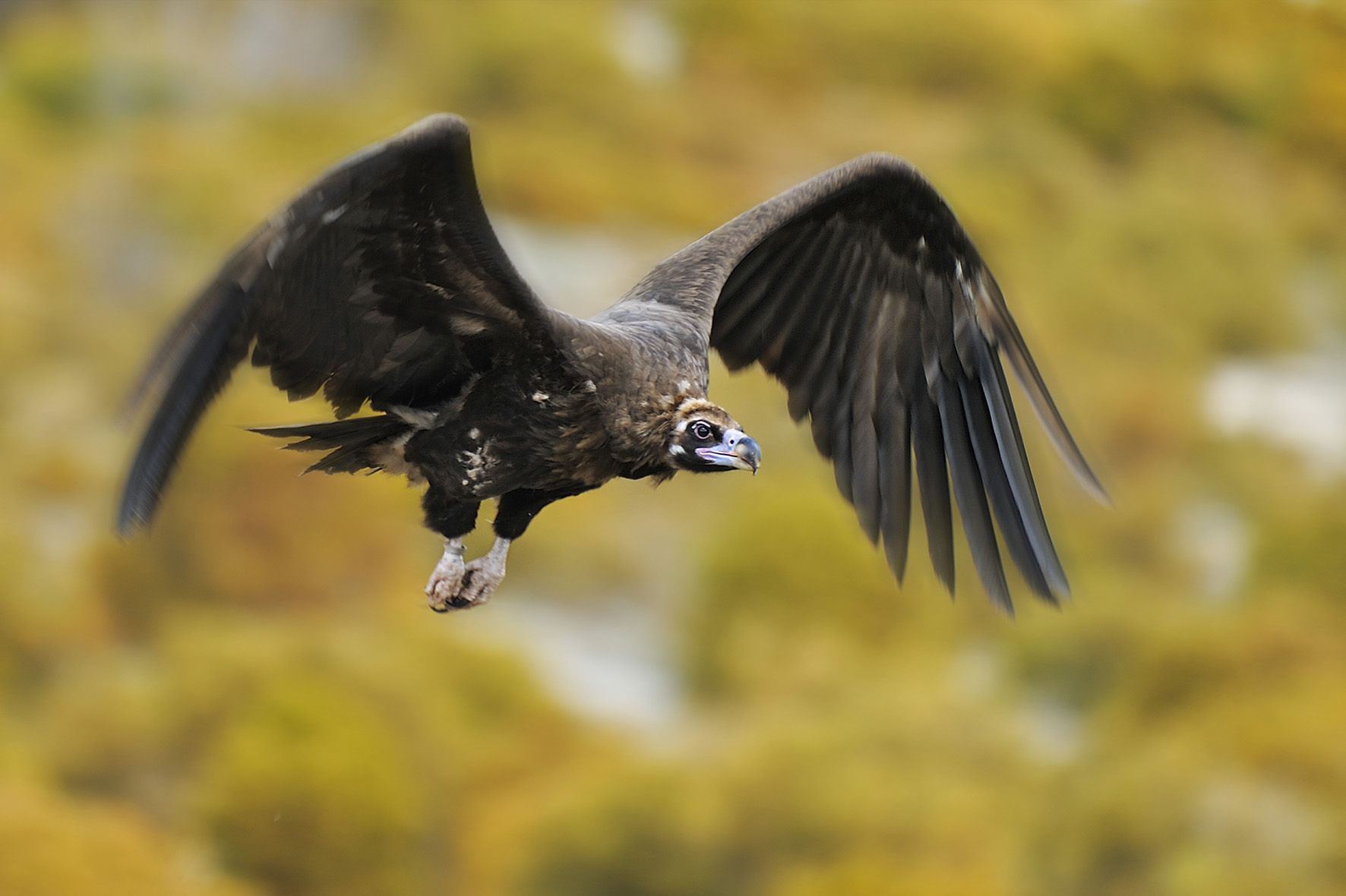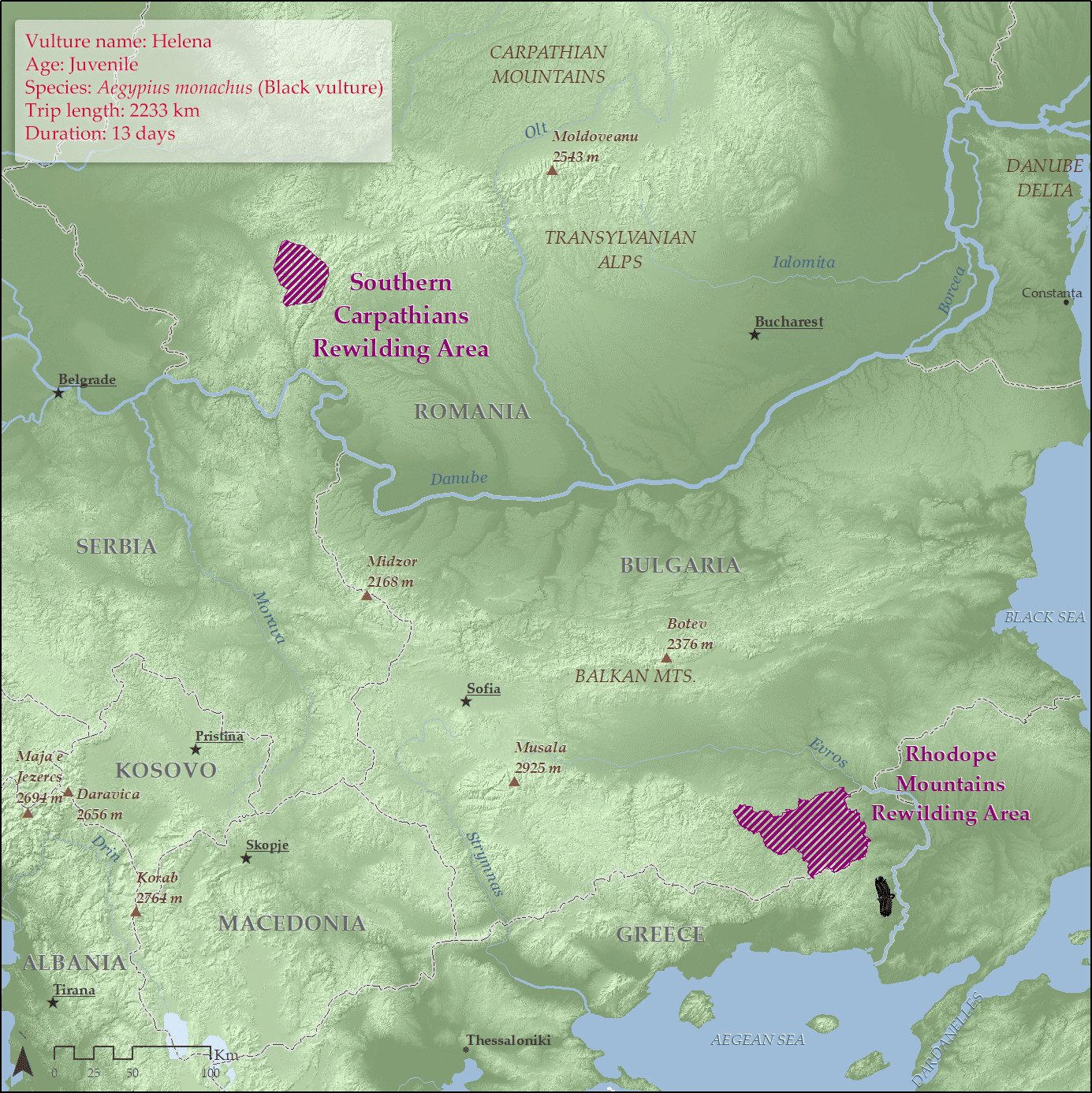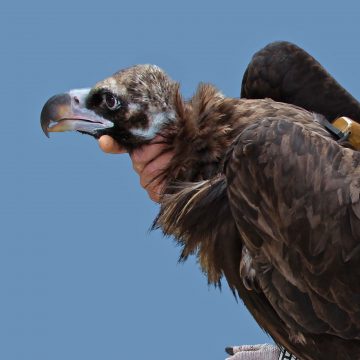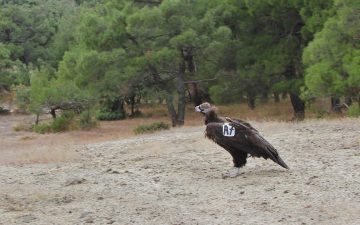The ongoing LIFE Vultures Project in Bulgaria and Greece has seen a number of black vultures tagged with GPS transmitters. Last year these showed one particular bird making a remarkable journey.

Fantastic flight
Black vultures are renowned for their majestic aerial prowess, as they soar through the sky on uplifting thermals. What they are far less well-known for is their nomadic behaviour – adult black vultures are generally thought to be sedentary birds, rarely straying far from their home territory.
It was therefore quite a surprise when last year a juvenile black vulture tagged with a GPS transmitter was found to have travelled nearly 2200 kilometres in 11 days. Born in Dadia National Park in northern Greece in 2014, “Helena” was tagged with a GPS transmitter in 2016 by a Greek team working in the park as part of the LIFE Vultures project.
Helena, who could have been male or female (both sexes look alike), began “her” cross-border journey in Dadia National Park on April 24, 2017. She flew over Bulgaria, then back into Greece, then Macedonia, Bulgaria again, Serbia and Romania, before finally heading south into Bulgaria for a third time, returning back to Dadia on May 4 to complete her Balkan circuit.
What is even more remarkable is that Helena actually flew directly over both the Southern Carpathians rewilding area in Romania, and the Rhodope Mountains rewilding area in Bulgaria. She actually chose to spend the night on a remote hill in the Southern Carpathians rewilding area on April 26.

“When Helena reached the Southern Carpathians the GPS track shows one fix on or above Mount Mic at 6:00 pm on April 26,” says Jelle Harms, Rewilding Europe’s GIS Data Manager. “Then there are a group of fixes on a hill near Poiana Marului from 8:00 pm on the same day, right through to 10:00 am the following morning.”
Helena’s flight was by far the longest recorded journey of any black vulture tagged as part of the LIFE Vultures project. While it’s impossible to say with certainty what drove her to make this amazing journey, it may just have been simple curiosity.

“The young are always inquisitive,” says Sylvia Zakkak, Head of Dadia National Park’s Monitoring/Supervision and Application Management Department (which is subcontracted by WWF Greece to participate in the LIFE Vultures project). “Black vultures have enough to eat in Dadia, so it certainly wasn’t hunger that inspired her wanderings. This vulture was possibly just doing some aerial reconnaissance, eventually got hungry, and came home.”
An alternative theory is that Helena may have been following an instinct to disperse, seeking out another location to colonise. If she had found another black vulture colony on her wanderings, she may have just stayed and bred. The Southern Carpathians were home to breeding colonies of black vultures in the not too distant past.
Today the Eastern Rhodopes of Greece are home to the only breeding colony of the black vulture in the Balkans, with around 20 to 30 pairs breeding annually in Dadia National Park. The number of breeding pairs has remained relatively stable in recent years.
Readers will be saddened to hear that Helena, who was into her fifth calendar year and seemed to have curbed her wanderlust, was recently discovered dead in Dadia National Park. It is likely that her death was caused by poisoning, although the local team are now awaiting the results of a toxicological analysis.
Despite being illegal, poisoned baits and carcasses are frequently put out by local people in the Rhodope Mountains with the aim of killing foxes, jackals, wolves and other animals that are seen as a threat to livestock. This can have a disastrous effect on vultures, which forage widely for such carrion. As part of the LIFE Vultures project, anti-poison dog units now patrol areas of the Rhodopes on both the Greek and Bulgarian sides of the border.
A progressive project

Starting in 2016, the five-year LIFE Vultures project was developed by Rewilding Europe, in collaboration with the Rewilding Rhodopes Foundation, BSPB/BirdLife Bulgaria and a range of other partners.
Focusing on the Rhodope Mountains rewilding area in Bulgaria, as well as a section of the Rhodope Mountains across the border in northern Greece, the aim of the project is to support the recovery and further expansion of the black and griffon vulture populations in this part of the Balkans, mainly by improving natural prey availability, and by reducing mortality through factors such as poaching, poisoning and collisions with power lines. The Fondation Segré is a key financial partner here, and we are grateful for their support.
Essential to maximising the success of the LIFE Vultures project is the tagging of both black and griffon vultures with GPS transmitters. As GPS data is systematically fed into a Geographic Information System (GIS), together with a range of other variables, so the rewilding team and their partners are gaining groundbreaking insight into the movement of vulture populations in the monitoring area, the various threats that they face, and the best ways to support the birds’ comeback.
Currently 24 active black vultures are tagged with transmitters in Greece (16 as part of the LIFE Vultures project), with a similar number of griffon vultures tagged in the Rhodopes rewilding area in Bulgaria. This month should see the launch of a dedicated website featuring semi-live tracking data, giving viewers their own fascinating insight into vulture movement in the Rhodope Mountains.
